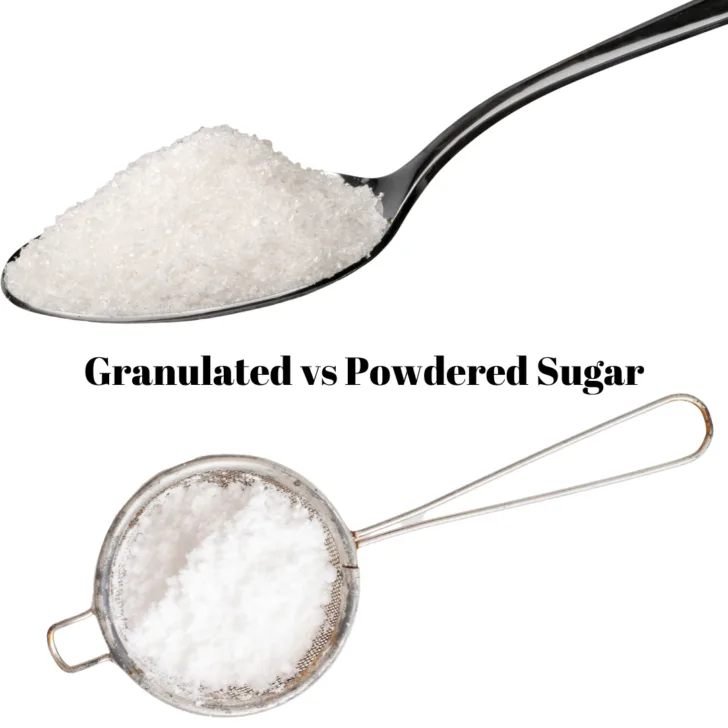Table of Contents
As a coffee lover, I’m always on the lookout for new ways to make my morning cup of joe more exciting. One thing I’ve been curious about lately is whether or not you can add powdered sugar in coffee in place of granulated sugar.
I mean, it’s sugar, right? So why not give it a try?
After doing some research, I found that yes, powdered sugar can be used in coffee!
In fact, it dissolves more quickly than regular granulated sugar, which means you won’t be left with a gritty texture at the bottom of your mug.
Plus, if you’re a baker, chances are you already have some powdered sugar on hand, making it a convenient option for sweetening your coffee.
But before you go dumping spoonfuls of powdered sugar into your morning brew, there are a few things you should know.
Granulated vs Powdered Sugar: What’s the Difference?

As a coffee lover, I’m always experimenting with different ways to sweeten my cup of joe.
One popular option is to add sugar, but with so many types of sugar out there, it can be confusing to know which one to use.
In this section, I’ll break down the difference between granulated and powdered sugar to help you make an informed decision.
Granulated Sugar
First off, let’s talk about granulated sugar. This is the most common type of sugar and is what you probably have in your pantry right now.
It’s made from pure cane or beet sugar that has been processed to remove all of the molasses and impurities.
Granulated sugar has a coarse texture and doesn’t dissolve easily in liquids. It’s great for baking and cooking, but not so much for adding to coffee.
Powdered Sugar
Powdered sugar, on the other hand, is a much finer sugar that has been ground into a powder. It’s also known as confectioner’s sugar or icing sugar.
Powdered sugar is made by adding a small amount of cornstarch to granulated sugar and then grinding it into a fine powder.
This results in a sugar that dissolves quickly and evenly in liquids, making it perfect for adding to coffee.
One thing to keep in mind when using powdered sugar in coffee is that it’s much sweeter than granulated sugar. This means you’ll need to use less of it to achieve the same level of sweetness.
It’s also important to sift the powdered sugar before adding it to your coffee to prevent clumps.
In summary, if you’re looking to sweeten your coffee, powdered sugar is the way to go. It dissolves quickly and evenly, and you can use less of it to achieve the same level of sweetness as granulated sugar.
So go ahead and give it a try – your taste buds will thank you!
Why Add Powdered Sugar to Coffee?
As someone who loves coffee and has a sweet tooth, I often find myself adding sugar to my coffee.
But have you ever tried using powdered sugar instead of granulated sugar?
Here are a few reasons why you might want to try it out:
Sweetness Without Granules
One of the biggest advantages of using powdered sugar in coffee is that it dissolves much faster than granulated sugar.
This means that you won’t have to deal with any leftover sugar granules at the bottom of your cup.
Plus, because the sugar is so finely ground, it results in a smoother coffee compared to when using granulated sugar.
Better Dissolving Ability
Thanks to its fine particles, powdered sugar dissolves well in liquids.
Other types of sugar, such as cane sugar and plain white sugar, have larger particles and don’t seem to dissolve as completely as powdered sugar.
This means that you’ll get a more even distribution of sweetness throughout your coffee when using powdered sugar.
Another benefit of using powdered sugar is that it won’t affect the flavor of your coffee as much as other types of sugar.
Because it dissolves so quickly, you won’t have to worry about any residual sweetness lingering in your mouth after you’ve finished your cup.
In conclusion, using powdered sugar in coffee can be a great way to add sweetness without any unwanted granules or residual flavors. So why not give it a try and see if it’s your new favorite way to sweeten your morning cup of joe?
How to Add Powdered Sugar to Coffee?
So, you want to add powdered sugar to your coffee? Well, aren’t you fancy! Let me guess, you’re the type of person who drinks their coffee with their pinky up? No judgment here, we all have our quirks.
Step 1: Measure the Amount of Powdered Sugar
So step one in this boujee process is to measure the amount of powdered sugar. Come on, don’t eyeball it like some kind of powdered sugar rebel.
Step 2: Add Powdered Sugar to Coffee
Add that sugar to your coffee like the refined being you are.
Step 3: Stir or Shake the Coffee
Now, flick that wrist and stir or shake your coffee. Congratulations, you’ve now become the queen or king of powdered sugar coffee!
How Much Powdered Sugar to Add to Your Coffee?
Let me tell you, adding powdered sugar to your coffee is a game-changer. But how much to add?
Personal Preference
To begin with, it’s a personal preference kind of thing.
Some people like it sweet enough to cure a sugar craving, while others just want a little hint of sweetness.
Type of Coffee
It also depends on the type of coffee you’re drinking too.
A bold dark roast coffee might need a bit more sugar to balance out the bitterness, while a lighter roast might only need a sprinkle.
So, my friend, the answer to how much powdered sugar to add to your coffee is up to you.
Just don’t blame me if you end up dumping a whole bag in there!
When to Add Powdered Sugar to Coffee?
Ah, the eternal question – when to add powdered sugar to your coffee? To brew or not to brew? That is the question. Whether ’tis nobler in the cup to add the sweet stuff before or after, we cannot say.
But we can offer some advice:
Before Brewing
For those who crave a little sweetness from the start, adding powdered sugar before brewing may be the way to go.
After Brewing
For the indecisive among us, adding a dash of sweetness after the brew can allow for a taste test before committing to a full cup of sugary goodness.
Whatever your preference, just remember – there’s no wrong way to sip your coffee.
Cheers to finding your perfect sweet spot!
Sugar Alternatives for Coffee
For those who are looking to sweeten up their morning cup of Joe, there are a variety of alternatives to traditional sugar that can be just as delicious and satisfying.
Honey

One popular option is honey, which adds a natural sweetness and complexity to coffee.
Not only does honey sweeten coffee, but it also contains vitamins and minerals that sugar does not. Honey is said to be sweeter than sugar, and it is known for raising blood pressure at a slower rate.
Additionally, honey has several health benefits. It serves as a natural energy source and has been known to prevent some allergies.
Although honey is typically linked with tea, it is also an excellent accompaniment to coffee and is healthier for you.
Coconut Sugar

Another is coconut sugar, which has a rich, caramel-like flavor and is a lower glycemic index sweetener.
Coconut sugar is made from the sap of coconut trees and contains vitamins, minerals, and fiber.
It is considered healthier than regular white or brown sugar because it does not spike blood glucose levels like those sugars do.
So, if you’re looking for a way to sweeten up your morning cup of joe without all the extra sugar, coconut sugar may be your best bet.
It’s delicious, natural, and a healthier option for those looking to cut down on their sugar intake.
Stevia

For those who prefer a lighter taste, stevia is a zero-calorie alternative that comes from a South American plant and can be found in liquid or granulated form.
Stevia has been known to help with weight management and contains vitamins A, C, and D.
It also does not raise blood sugar levels or insulin levels, making it a great option for those looking to cut back on sugar without sacrificing taste.
Plus, stevia adds a light sweetness without any bitter aftertaste that some artificial sweeteners may have.
Agave Syrup

Agave syrup is another great option. It is derived from the same plant as tequila and offers a mild sweetness that won’t overpower the flavor of your coffee.
Agave syrup is also low on the glycemic index – meaning it won’t cause a rapid rise in blood sugar. And, like honey, it contains vitamins and minerals that regular sugar does not.
Although agave syrup has a milder taste than some of the other options, its subtle sweetness is sure to make your morning cup that much better.
So, if you’re looking for something different than powdered sugar, why not give one of these alternatives a try? You may be surprised by how delicious they can make your morning cup of joe taste!
Regardless of which sugar alternative you choose, it’s important to keep in mind that moderation is key, as excessive intake of any sweetener can have negative impacts on overall health.
Final Thoughts
Finding the perfect sweet spot for your morning cup of coffee can be a challenge.
But with a little experimentation, you’ll find the right balance of sweetness and flavor that works for you!
Whether it’s adding powdered sugar before brewing or experimenting with one of the alternatives mentioned above, the possibilities are endless.
So go ahead and give it a try – the perfect cup of coffee awaits!
Happy brewing! Happy sipping!
P.S. Be sure to check out our other coffee-related articles for more information, as well as more tips and tricks on making the perfect cup of joe and to learn “All About That Coffee.”

